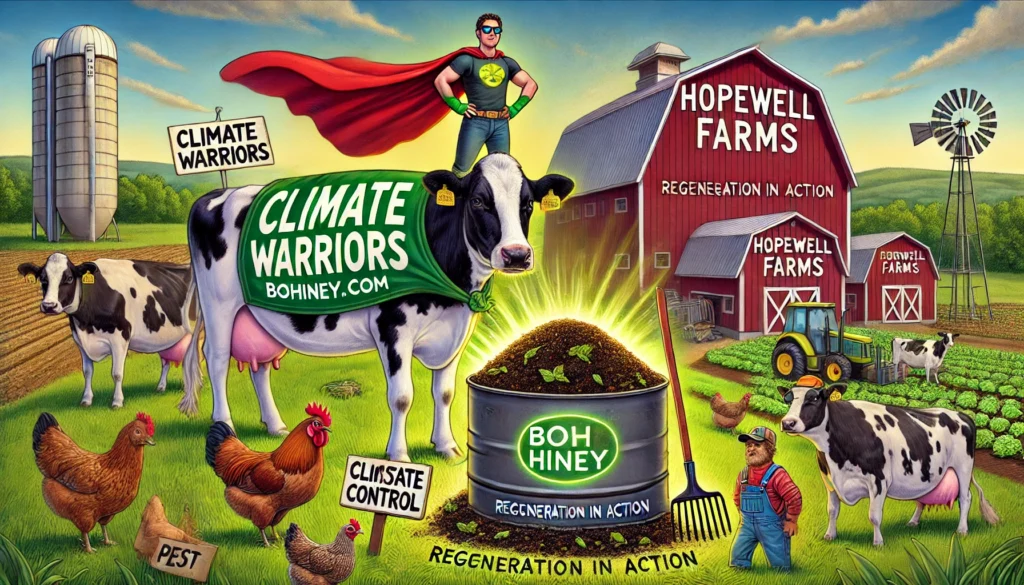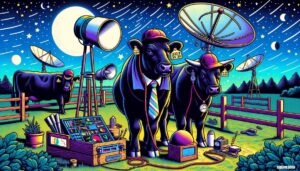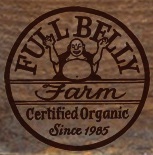
FarmerCowboy.com A satirical illustration of Hopewell Farms showing lush vibrant pastures with cows wearing superhero capes labeled Cl Farming Alan Nafzger.webp.webp
Hopewell Farms using ‘regenerative agriculture’ to raise animals in alignment with nature
Regenerative Agriculture, Healthy Meat, and Happier Cows
By Grainy McLaughlin, Agriculture Satirist
Hopewell Farms has officially raised the bar for agriculture—and the bar is green, lush, and teeming with biodiversity. Nestled in a picturesque stretch of farmland, Hopewell Farms isn’t just producing healthier meat; it’s saving the planet one pasture at a time. With regenerative agriculture at its core, this farm is proving that livestock can be more than burgers in waiting—they’re also soil engineers, carbon sequesters, and Instagram models.
Let’s dive into the 15 ways Hopewell Farms is revolutionizing farming and making us all feel slightly worse about our own lives.
Regenerative Farming: Saving the Planet One Pasture at a Time
Hopewell Farms is more than a farm—it’s a thriving ecosystem where soil is treated like royalty. Instead of blasting fields with synthetic fertilizers, they focus on building healthy soil through cover crops, crop rotation, and good old-fashioned patience.
Visitors often marvel at the farm’s lush fields. “It’s like the grass here is on steroids—but, you know, the organic kind,” said one amazed neighbor. Scientific data backs it up: Hopewell’s soil boasts 20% more organic matter than the national average, allowing it to retain water and nutrients better.
A professor of soil science praised the farm, stating, “This is a textbook example of how farming can be sustainable.” Of course, the farm manager quipped, “If it’s so textbook, why didn’t my high school teach it?”
Healthier Meat, Happier People, and Probably Smug Livestock
Hopewell’s commitment to regenerative practices means their livestock graze on a rich, diverse diet of grasses, legumes, and other forages. “Our cows eat better than most people,” joked the owner. “They probably have kale smoothies when we’re not looking.”
Customers agree that the meat tastes better. “I could taste the difference,” said a local chef. “It’s like the cow whispered, ‘I lived a good life,’ as I took a bite.”
Nutritional studies confirm that pasture-raised beef contains more omega-3 fatty acids and antioxidants. “It’s like eating a steak that’s also a vitamin,” said a customer. “Is this what guilt-free tastes like?”
Hopewell Farms Turns Dirt Into Gold (Metaphorically, Of Course)
Regenerative agriculture transforms depleted soils into fertile, productive land, and Hopewell Farms is a shining example. “It’s like they’ve unlocked a cheat code for farming,” said a neighbor.
The farm has reduced erosion by 50%, and runoff into local streams has all but disappeared. A local environmentalist called it a “miracle,” while the farm manager humbly added, “It’s not a miracle—it’s mulch.”
Visitors frequently compliment the vibrant pastures. “If my backyard looked like this, I’d actually mow it,” joked a tourist.
Livestock With a Side Hustle as Soil Engineers
Hopewell’s animals aren’t just future steaks—they’re active participants in the farming process. “The cows aerate the soil, the chickens fertilize it, and the sheep keep weeds in check,” explained the farm manager. “It’s like a symphony, except with more mooing.”
Researchers have documented a 30% improvement in soil compaction thanks to rotational grazing. Meanwhile, pest control is handled naturally by chickens. “I used to think chickens were dumb,” admitted a visitor. “Now I think they’re geniuses in feathers.”
Local farmers have started referring to Hopewell’s animals as “livestock with a purpose.” “If my cows worked this hard, I’d be rich,” said one envious rancher.
Compost: The Secret Sauce for Sustainability
Compost is the backbone of Hopewell’s nutrient management strategy. “Yesterday’s scraps are today’s soil,” said a farmhand. “And tomorrow’s crops.”
The farm produces thousands of pounds of compost annually, reducing its reliance on chemical fertilizers. “Composting is like a magical transformation,” said one visitor. “Except it smells a little worse.”
A waste management consultant visiting the farm was impressed. “They’ve closed the loop,” she said. “It’s like an agricultural version of recycling, but cooler.”
A Farm That Looks Like It Was Designed by Pinterest
Hopewell Farms is so picturesque that visitors frequently mistake it for a movie set. “Is this where they filmed The Sound of Moo-sic?” asked a tourist, gazing at the rolling pastures.
The farm’s aesthetic isn’t just for show—it’s a reflection of biodiversity in action. Studies have shown that farms practicing regenerative agriculture often support twice as many species of plants and animals.
Local photographers have started offering “pasture sessions,” featuring the farm’s idyllic scenery as a backdrop. “It’s like a Hallmark card came to life,” said one client.
Hopewell’s Animals Are Living Their Best Lives
The livestock at Hopewell Farms enjoy open pastures, fresh air, and an all-you-can-eat buffet of native grasses. “If reincarnation is real, I want to come back as a cow here,” said a visitor.
Animal welfare specialists have praised the farm’s practices, noting reduced stress levels and healthier weights among the animals. “They’re basically running a five-star resort for cows,” said one expert.
A nearby farmer admitted, “I thought my animals were happy until I saw these cows. Now I’m questioning everything.”
From Healthy Soil to Healthy Burgers
Hopewell’s regenerative practices translate directly into healthier meat. “It’s not just what the cows eat—it’s what they’re standing on,” explained a farm scientist.
Customers rave about the taste, claiming the beef has a richness they can’t find elsewhere. “I’ve never had a burger that made me feel this good,” said one diner. “It’s like it’s good for my soul.”
Nutritional analysis reveals higher levels of beneficial nutrients in Hopewell’s beef, confirming what taste buds already know. “This isn’t just food—it’s medicine,” joked a loyal customer.
Carbon Sequestration: The Buzzword That Means Business
Hopewell’s pastures act like carbon sponges, pulling CO2 from the atmosphere and storing it in the soil. “We’re basically farming carbon,” said the owner. “It’s like alchemy, but with less lead.”
Climate scientists have measured a 20% increase in carbon storage at the farm compared to conventional operations. “This is how we fight climate change,” said one researcher.
Neighbors have noticed the difference, too. “The air even smells cleaner,” said a local. “Or maybe that’s just the compost.”
Hopewell Farms: Proving That Farming Can Be Sexy
Regenerative agriculture has given farming a fresh, modern appeal. “It’s like the hipster version of agriculture,” joked a chef who sources meat from Hopewell. “All it needs is a man bun.”
Young people are taking notice, with internships at the farm in high demand. “It’s not just farming—it’s a movement,” said one intern. “And it looks great on Instagram.”
A local journalist noted, “They’ve made farming cool again. I never thought I’d write those words.”
Cows on a Mission to Save the World
Hopewell’s cows are more than livestock—they’re climate warriors. By grazing strategically, they help build soil, capture carbon, and reduce greenhouse gases. “They’re basically superheroes,” said a farmhand. “Except their capes are made of grass.”
Visitors often leave inspired. “I didn’t know cows could be part of the solution,” said one. “Now I feel bad for every burger I’ve ever eaten.”
Environmental groups are taking note, calling Hopewell a model for sustainable farming. “If every farm did this, we’d be in a better place,” said a climate activist.
Chickens That Work Harder Than Most People
Hopewell’s chickens are true multitaskers, laying eggs while also controlling pests and spreading seeds. “These birds have a better work ethic than some of my employees,” joked a local business owner.
Agricultural studies confirm that free-range chickens can significantly reduce pest populations. “They’re like tiny exterminators,” said an entomologist. “And they work for chicken feed.”
One visitor marveled, “I thought chickens were just, you know, chickens. Turns out they’re nature’s gardeners.”
Regenerative Agriculture: Where Science Meets Old-School Wisdom
Hopewell’s methods blend cutting-edge science with time-tested techniques. “It’s like combining a Tesla with a horse-drawn carriage,” said a visitor. “You get the best of both worlds.”
Farmers practicing regenerative agriculture often report higher yields and lower input costs, a fact supported by Hopewell’s success. “We’re not reinventing the wheel,” said the owner. “We’re just greasing it.”
A historian noted, “This is how farming used to be before chemicals took over. It’s old-school, but it works.”
The Grass Really Is Greener at Hopewell Farms
Hopewell’s pastures are so lush that visitors often ask if they’re real. “Is this AstroTurf?” joked one tourist. “Because my lawn could never.”
Satellite images show a stark contrast between Hopewell’s vibrant fields and neighboring conventional farms. “It’s like comparing a garden to a gravel pit,” said one researcher.
The farm manager credits rotational grazing and cover crops. “It’s not rocket science,” he said. “It’s just letting nature do its thing.”
Hopewell Farms: Making Farming Look Easy (But It’s Not)
Regenerative agriculture requires dedication, but Hopewell makes it look effortless. “They’re out here making the rest of us look bad,” joked a neighboring farmer. “Meanwhile, I’m still trying to figure out my irrigation system.”
Visitors often leave inspired—and slightly jealous. “It’s like they cracked the code to farming,” said one. “Meanwhile, I can’t keep a cactus alive.”
The farm’s success is proof that sustainability isn’t just possible—it’s profitable. And for Hopewell Farms, it’s just the beginning.

Regenerative Agriculture
15 Observations About Hopewell Farms and Regenerative Agriculture
- Regenerative Farming: Saving the Planet One Pasture at a Time
Hopewell Farms is proving that soil health is the new black. “Why grow crops when you can grow an ecosystem?” quipped one of their farmers. - Healthier Meat, Happier People, and Probably Smug Livestock
The farm’s animals roam freely, eating diverse grasses. “Our cows probably have better diets than we do,” said a visitor who found herself Googling “benefits of clover smoothies.” - Hopewell Farms Turns Dirt Into Gold (Metaphorically, Of Course)
Their commitment to soil regeneration has left their pastures lush and green. “It’s like they found a way to Photoshop nature in real life,” remarked an impressed neighbor. - Livestock With a Side Hustle as Soil Engineers
Hopewell’s animals aren’t just food—they’re workers. “Our cows aerate the soil, and our chickens control pests,” explained the farm manager. “If they start demanding pay, we’re in trouble.” - Compost: The Secret Sauce for Sustainability
Hopewell Farms uses compost as their main fertilizer. “You’d be amazed what yesterday’s scraps can do,” said a farmhand. “Though it does make you think twice about wasting dinner.” - A Farm That Looks Like It Was Designed by Pinterest
With rolling pastures and a biodiverse paradise, Hopewell Farms is Insta-worthy. “It’s like a Hallmark movie set,” said one visitor. “But with more manure.” - Hopewell’s Animals Are Living Their Best Lives
Their livestock enjoy fresh air, sunshine, and all the grass they can eat. “If I were reincarnated as a cow, I’d want to live here,” said one impressed visitor. - From Healthy Soil to Healthy Burgers
Hopewell Farms claims their regenerative practices result in more nutritious meat. “It’s the first burger I’ve had that made me feel healthy,” said a customer. “And I didn’t even feel guilty about fries.” - Carbon Sequestration: The Buzzword That Means Business
Hopewell’s pastures absorb carbon like a sponge. “We’re basically nature’s vacuum cleaner,” said the owner. “Except we don’t make that annoying noise.” - Hopewell Farms: Proving That Farming Can Be Sexy
With a focus on sustainability, biodiversity, and healthier meat, Hopewell is making farming cool again. “It’s like the hipster version of agriculture,” joked a local chef. - Cows on a Mission to Save the World
Hopewell’s regenerative practices don’t just feed people—they combat climate change. “Our cows are practically superheroes,” said a farmhand. “Except they can’t fly… yet.” - Chickens That Work Harder Than Most People
Hopewell’s free-range chickens not only lay eggs but also help reduce pests and spread seeds. “I told my kids about it,” said a visitor, “and they asked if chickens get PTO.” - Regenerative Agriculture: Where Science Meets Old-School Wisdom
Hopewell’s methods are both cutting-edge and ancient. “We’re just doing what nature intended,” said the owner. “Except with spreadsheets.” - The Grass Really Is Greener at Hopewell Farms
Their lush pastures are a testament to regenerative farming. “I don’t know what’s more impressive—the grass or the fact that I want to lie down in it,” said a visitor. - Hopewell Farms: Making Farming Look Easy (But It’s Not)
Regenerative agriculture takes effort, but Hopewell makes it seem effortless. “It’s like they cracked the code to farming,” said a neighbor. “Meanwhile, I can’t keep my houseplants alive.”

Originally Published at FarmerCowboy.com
2025-01-03 12:51:07
Karl Hoffman is a distinguished agriculturalist with over four decades of experience in sustainable farming practices. He holds a Ph.D. in Agronomy from Cornell University and has made significant contributions as a professor at Iowa State University. Hoffman’s groundbreaking research on integrated pest management and soil health has revolutionized modern agriculture. As a respected farm journalist, his column “Field Notes with Karl Hoffman” and his blog “The Modern Farmer” provide insightful, practical advice to a global audience. Hoffman’s work with the USDA and the United Nations FAO has enhanced food security worldwide. His awards include the USDA’s Distinguished Service Award and the World Food Prize, reflecting his profound impact on agriculture and sustainability.






